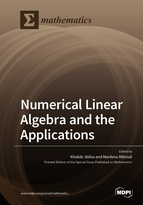Numerical Linear Algebra and the Applications
A special issue of Mathematics (ISSN 2227-7390). This special issue belongs to the section "Difference and Differential Equations".
Deadline for manuscript submissions: closed (30 April 2021) | Viewed by 12468
Special Issue Editors
2. Laboratory MSDA, University Polytechnic Mohammed VI, Benguerir 43150, Morocco
Interests: Linear algebra; computer science; numerical analysis; Ill-posed problems
Special Issue Information
Dear Colleagues,
Numerical linear algebra is a very important topic in mathematics and has important recent applications in deep learning, machine learning, image processing, applied statistics, artificial intelligence and other interesting modern applications in many fields. The purpose of this Special Issue in Mathematics is to present the latest contributions and recent developments of numerical linear algebra and applications in different real domains. We invite authors to submit original and new papers and high-quality reviews related to the following topics: applied linear algebra, linear and nonlinear systems of equations, large matrix equations, numerical tensor problems with applications, ill-posed problems and image processing, linear algebra and applied statistics, model reduction in dynamic systems and other related subjects. The submitted papers will be reviewed in line with the traditional submission process.
This Special Issue will be dedicated to the inspired mathematician Constantin Petridi, who has devoted his life to mathematics.
Prof. Dr. Khalide Jbilou
Prof. Dr. Marilena Mitrouli
Guest Editors
Manuscript Submission Information
Manuscripts should be submitted online at www.mdpi.com by registering and logging in to this website. Once you are registered, click here to go to the submission form. Manuscripts can be submitted until the deadline. All submissions that pass pre-check are peer-reviewed. Accepted papers will be published continuously in the journal (as soon as accepted) and will be listed together on the special issue website. Research articles, review articles as well as short communications are invited. For planned papers, a title and short abstract (about 100 words) can be sent to the Editorial Office for announcement on this website.
Submitted manuscripts should not have been published previously, nor be under consideration for publication elsewhere (except conference proceedings papers). All manuscripts are thoroughly refereed through a single-blind peer-review process. A guide for authors and other relevant information for submission of manuscripts is available on the Instructions for Authors page. Mathematics is an international peer-reviewed open access semimonthly journal published by MDPI.
Please visit the Instructions for Authors page before submitting a manuscript. The Article Processing Charge (APC) for publication in this open access journal is 2600 CHF (Swiss Francs). Submitted papers should be well formatted and use good English. Authors may use MDPI's English editing service prior to publication or during author revisions.
Keywords
- linear algebra
- matrix equations
- applied statistics
- tensor algorithms
- image processing
- ill-posed problems
- model reductions







